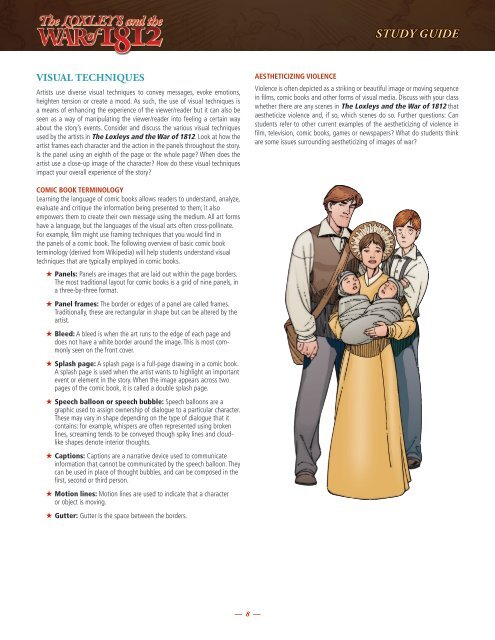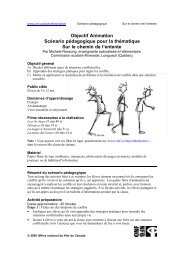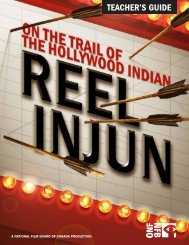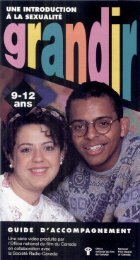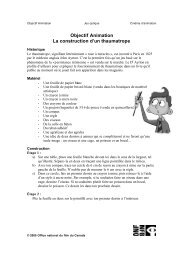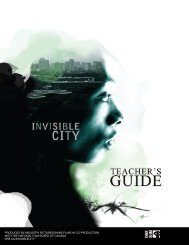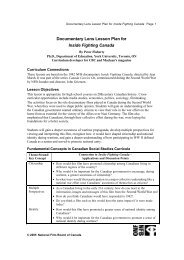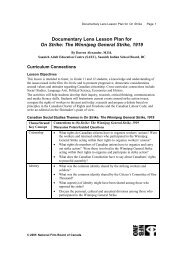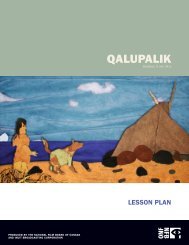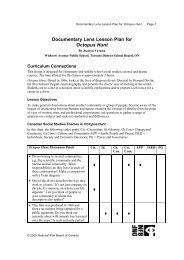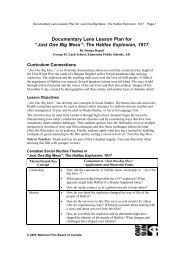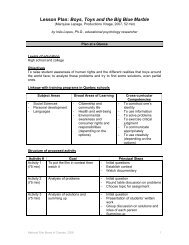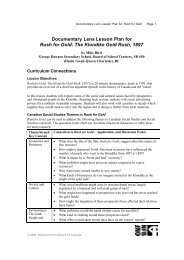Study guide - Office national du film du Canada
Study guide - Office national du film du Canada
Study guide - Office national du film du Canada
- No tags were found...
Create successful ePaper yourself
Turn your PDF publications into a flip-book with our unique Google optimized e-Paper software.
STUDY GUIDEVISUAL TECHNIQUESArtists use diverse visual techniques to convey messages, evoke emotions,heighten tension or create a mood. As such, the use of visual techniques isa means of enhancing the experience of the viewer/reader but it can also beseen as a way of manipulating the viewer/reader into feeling a certain wayabout the story’s events. Consider and discuss the various visual techniquesused by the artists in The Loxleys and the War of 1812. Look at how theartist frames each character and the action in the panels throughout the story.Is the panel using an eighth of the page or the whole page? When does theartist use a close-up image of the character? How do these visual techniquesimpact your overall experience of the story?AESTHETICIZING VIOLENCEViolence is often depicted as a striking or beautiful image or moving sequencein <strong>film</strong>s, comic books and other forms of visual media. Discuss with your classwhether there are any scenes in The Loxleys and the War of 1812 thataestheticize violence and, if so, which scenes do so. Further questions: Canstudents refer to other current examples of the aestheticizing of violence in<strong>film</strong>, television, comic books, games or newspapers? What do students thinkare some issues surrounding aestheticizing of images of war?COMIC BOOK TERMINOLOGYLearning the language of comic books allows readers to understand, analyze,evaluate and critique the information being presented to them; it alsoempowers them to create their own message using the medium. All art formshave a language, but the languages of the visual arts often cross-pollinate.For example, <strong>film</strong> might use framing techniques that you would find inthe panels of a comic book. The following overview of basic comic bookterminology (derived from Wikipedia) will help students understand visualtechniques that are typically employed in comic books.★ Panels: Panels are images that are laid out within the page borders.The most traditional layout for comic books is a grid of nine panels, ina three-by-three format.★ Panel frames: The border or edges of a panel are called frames.Traditionally, these are rectangular in shape but can be altered by theartist.★ Bleed: A bleed is when the art runs to the edge of each page anddoes not have a white border around the image. This is most commonlyseen on the front cover.★ Splash page: A splash page is a full-page drawing in a comic book.A splash page is used when the artist wants to highlight an importantevent or element in the story. When the image appears across twopages of the comic book, it is called a double splash page.★ Speech balloon or speech bubble: Speech balloons are agraphic used to assign ownership of dialogue to a particular character.These may vary in shape depending on the type of dialogue that itcontains: for example, whispers are often represented using brokenlines, screaming tends to be conveyed though spiky lines and cloudlikeshapes denote interior thoughts.★ Captions: Captions are a narrative device used to communicateinformation that cannot be communicated by the speech balloon. Theycan be used in place of thought bubbles, and can be composed in thefirst, second or third person.★ Motion lines: Motion lines are used to indicate that a characteror object is moving.★ Gutter: Gutter is the space between the borders.— 8 —


